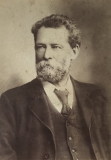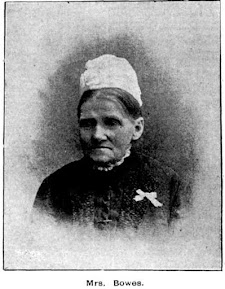The Funeral Director from humble origins
How many of us who attend funerals ever really think about how the role of the Funeral Director came to be? Not many I'd say. Today's post is about one such man who saw an opportunity and pursued it.
JOSEPH TAYLOR COFFILL
Joseph was born in Kensington, London in May 1841 to Joseph and Margaret Coffill, his father was a farmer of French Huguenot descent and his mother was from Edinburgh.
As a young lad, Joseph tried his hand at various occupations such as a porter and mortar mixer but by the age of 21 he decided that Australia was the land of opportunity and worked his passage as a seaman cook arriving in Brisbane in 1865.
Joseph set up business as a carter and carried between Gympie, Rockhampton and Cloncurry. Although this was his main occupation he also found time to run a blacksmith's forge as well as trying his hand at copper mining in Cloncurry. Joseph had a life long love of horses and became a successful dealer. During his time in Queensland he took up droving making many 1500 mile journeys from Brisbane to Sydney. No one could say that Coffill was afraid of hard work!
Image of drovers in 19th century Australia from Australian Food Timetable
In 1878 Coffill decided to move to Sydney where there were more opportunities. He had accumulated enough wealth to buy a large property with substantial stables in Ultimo which he named "Ultimo House" That same year he married Elizabeth Ann Bates who in 1879 gave birth to a son, Harold James. Soon after the birth a fire broke out at the house and quickly became out of control but both mother and son were rescued. Soon after Elizabeth developed pneumonia and died with Harold then being raised by his maternal grandparents.
Joseph dealt with his grief with increasing hard work and took up a hansom cab business and let out some of his stables. Later in 1879 he opened a depot where commercial buggies and sulkies were let and it wasn't long before he had an average of fifty such vehicles hired out each morning. In 1881 Coffill married Anne Ivory and the union over the years produced nine children.
In the meantime business was flourishing. His carriages, hearses and other means of transport were the most opulent in Sydney attracting vice-regal patronage. Another branch of "Coffills" was opened next to the Australia Hotel and when demand for wedding coaches increased Joseph was there to reap the benefits.
While his business was booming Coffill suffered another tragedy with his wife Anne dying in 1894 just after giving birth to their ninth child. Joseph was left to care for his large family whose ages ranged from twelve years down to under one year. He had plans to move to another residence and did so, into a two storey building in Harris Street which he named "Kensington" after his English birthplace.
Once again Coffill buried himself in work but records reveal much time was spent with his family and in 1897 he married for a third and final time to Ada, a widow with four daughters who was also a hotel owner. Ada also possessed an unusual qualification being that of an embalmer; a rather fortuitous skill that helped Joseph expand his business further. With his ability to manufacture coffins and provide hearses together with embalming skills he was able to include the title of "Funeral Director" to his Carriage Operator moniker.
Horse drawn hearse - wikipedia
As Coffill's funeral business was now all "in house" he could offer cheaper rates with many more people able to afford a larger traditional funeral which was greatly appreciated by those on lower budgets. Besides the conventional hearse, Joseph was able to offer speciality hearses, such as a children's one pulled by a series of grey's or the Italian Renaissance style hearse whose carving alone had taken more than two years to complete.
The company continued to expand and new branches opened throughout Sydney's suburbs. Between 1901 and 1910 Coffill travelled extensively to Europe and America observing trends in the funeral business. Whilst in America in 1910 he expressed that he "felt some pangs for the future of the horse".
As was common with businessmen, he held many positions. Coffill was a Freemason and was President of the United Grand Lodge, Sydney from 1901-1904. He was represented on many Boards of Hospitals and of the NSW Benevolent Society amongst others.
Joseph retired in 1912 and invited his friend AJC Wood to join him and form a Public Company known as "Wood Coffill Ltd". Coffill died on 8 April 1919 at his residence "Curraweena" Homebush survived by his third wife Ada and ten children from his first and second marriages and one daughter from his third.
Advertisement taken from "The Sun" June 21 1912 - Trove
Coffill made a very successful business for himself and his family and proved to be another immigrant success story rising from humble beginnings to that of a respected elder of the community albeit with personal tragedy along the way. He would have been very interested to see that one of his sons Joseph Frederick who became the Senior Conductor for "Wood Coffill Ltd" oversaw the transition from the horse to motorised hearses in 1942.
Motorised hearse - Wikipedia
Joseph Coffill lies peacefully with his second wife Anne and the ashes of his son Joseph Frederick, mentioned in the previous paragraph, under a humble headstone - which unfortunately is extremely hard to read due to the type of stone used - in the Old Anglican area of the Cemetery in Zone B, Section AAA, plot 100.
Coffill's unfortunately rather hard to read headstone in Rookwood
In the meantime read more about Joseph Taylor Coffill at :-
https://adb.anu.edu.au/biography/coffill-joseph-taylor-joe-12847
or search many other entries in google, ancestry or trove





.JPG)



Comments
Post a Comment